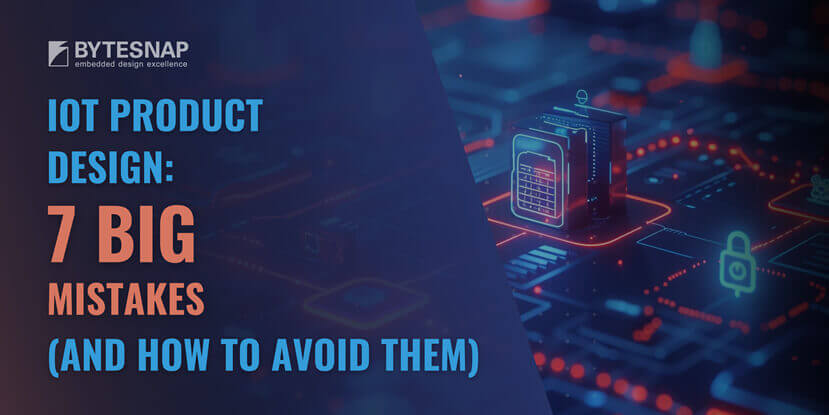Avoiding the most common pitfalls in IoT product design
The Internet of Things IoT market is booming in the UK and worldwide, and is expected to do so for many years to come.
Smart connected devices in industry, enterprise and at the consumer level continue to see growth in adoption, and any business successfully innovating can expect financial success.[i]
But not unlike a digital gold rush, the pursuit of a successful IoT product design comes with pitfalls and errors. Only 26% of IoT projects successfully go to market, while 60% look good on paper and then falter partway through.[ii]
Here are the seven most significant pitfalls of product development, and the best steps to avoid them.

The 7 biggest mistakes in IoT product development are:
1. Energy inefficiency
2. Cost too high
3. Failing standards, compatibility or compliance
4. Poor radio range
5. Right product, wrong time
6. Great product design, unavailable parts
7. Too much solution, not enough problem
Let’s dive into the detail.
Energy Inefficiency
The most mundane aspects of production are often the most overlooked, yet all can ruin a design.
Energy efficiency is often treated as an afterthought, but despite being seen as incidental to the device’s design and engineering, it’s a vital aspect of both consumer and industrial IoT.
Customers will be looking for devices that will be both inexpensive and easy to use.
Any product with poor energy efficiency may mean a short battery life and frustration for consumers, or it may mean increased overheads and a real impact on business profits.
What to do: The earlier you have a working analysis of energy consumption in the product design, the better; the further into design you are, the harder it becomes to fix these issues. Potential solutions depend on the nature and scope of your IoT device.
If the device uses more flexible software or has its own OS, you may be able to implement an intelligent sleep mode and other forms of power conservation. Smaller and more specialised devices, such as those produced by Tibber, a Stockholm-based EnergyTech startup, may need hardware redesigns to use more energy-efficient parts and consider alternative power sources.

Cost Too High
Product design and prototyping is more accessible today than it has ever been, with ‘prosumer’ markets opening in a huge variety of creative and technical fields.
Products like Arduino and Raspberry Pi have helped to significantly lower barriers to technical design, circuitry and programming.
For the most part, this is excellent news, but it can lead to new pitfalls when a design or prototype goes to manufacture.
Blueprints or even a working example device may be within an individual’s personal budget, but this doesn’t reflect the costs of production and manufacture.
According to some estimates, an IoT project will cost an average of $30,000-50,000 (about £23,000-£38,000) for a minimum viable product, with more advanced designs potentially costing in the hundreds of thousands.
What to do: Research is key.
A thorough cost analysis must be incorporated into the design process; you can’t afford not to think beyond the end product.
Every phase of creation and production must be planned. Analyse what parts each unit of your product will need, and how much it will cost to meet the manufacturing needs.
Ascertain whether the production process itself will incur additional costs, such as skilled labour or any third-party production resources.
Any organisation or start-up needs to be brutally honest with itself about how likely a project is to recoup its cost.
Failing Standards, Compatibility or Compliance
Being functional is not always enough for a device to be fit for purpose. Without care and attention to regulations, industry standards, or compatibility, even the most well-designed product can be more of a liability than an asset.
As IoT devices are at the intersection of the digital and physical worlds, they must meet compliance standards for both electrical safety and cybersecurity. Some industry standards may not be legally required, but are still necessary to ensure a successful, compatible product.
Any new IoT device must be GDPR compliant, and pass all relevant EMC and RF testing and a slew of electronic safety standards, such as Zigbee or Bluetooth Mesh, to guarantee reliability and scalability at a rapid rate, or the business risks not just a failed product but hefty fines from regulators.
It is also important to ensure compatibility with major companies such as Amazon, Apple, and Google by following the Matter standard for communication between different IoT devices.
What to do: Especially for smaller or more independent enterprises, issues of compatibility and compliance can be intractable.
Resolving issues with confidence requires access to in-depth knowledge and expertise of the law, connectivity standards and market trends. Engaging outside assistance may be the best option.
ByteSnap has experience working closely with IoT device producers to help meet legal standards and maximise compatibility. When assisting Cocoon with its smart home security system, ByteSnap was able to ensure full EMC compatibility as well as optimise the wireless data rate and RF performance thanks to the knowledgeable team bringing together in-depth experience across multiple fields.[iii]

Poor Radio Range
It’s a common mistake to forget that the real world will be different to the product testing lab.
A successful IoT device must have consistent, reliable uptime, whether in consumer IoT or industrial IoT. As soon as a device develops a reputation for losing connection or having an impractically short radio range, it can be impossible to salvage.
This puts developers in a difficult position, as the broader a device’s wireless range, the more expensive it is to produce.
To avoid this mistake, it is crucial to carefully consider the user interface during the design process to ensure a seamless and intuitive experience for users. Also, keep in mind that it’s essential to have an overview of the various protocols and standards used in IoT product design to ensure consistent and reliable performance.
What to do: First, remember that a failed product design will always be more costly than a successful one, and sometimes success can only be achieved by making investments in the product’s quality.
It’s good practice to think of not only the intended use of the device, but also other ways customers might want to use it, and make sure that the design allows for as much flexibility as possible, especially for a type of product with potential design challenges like IoT devices.
Hark provides a good example with its smart laboratory monitoring device. Although conceived for indoor labs and small buildings, Hark made the call to get help from ByteSnap to broaden the scope for their IoT devices to connect over longer distances, with more flexibility.
ByteSnap’s radio communications expertise in collaboration with Hark led to ground-breaking new technology for the pharmaceutical sector, without breaking Hark’s budget or timeframes. [iv]
Right Product, Wrong Time
Timing is no joke in the IoT device world. The most well-conceived, high-quality product can still fail if brought to market at the wrong time, and market trends can make or break any product.
Demand for leisure IoT devices dropped considerably during the Covid-19 pandemic. However, as lockdowns have eased, enterprise IoT has surged, with more businesses seeking smart connectivity solutions.
Creating a supply where there is no demand or employing outdated technology in your design will lead to failure.[v]
What to do: It’s important to never neglect the business aspect of product development. You aren’t simply creating a product, you’re marketing, selling and supporting one too.
Market research will give a clearer impression of your target demographics, their needs, and their financial situations. Make sure to keep a close eye on the competition, and determine if a rival product could pose a challenge to your success.
Remember that an IoT project can take over a year to launch, and a lot can change in that time. Make sure your product design and marketing strategy can withstand foreseeable market fluctuations.
Great Product Design, Unavailable Parts
Another way that a well-designed product can fail is due to supply chain issues.
This doesn’t only affect small businesses and start-ups; in 2021, Apple was forced to lower its iPhone production by over 10 million units due to supply shortages in many Asian countries.
For a company as big as Apple, this was merely a dent in their production schedule, but for smaller businesses even disruption with a fraction of this impact could cripple production.[vi]
What to do: Unfortunately, supply chain problems don’t always have a solution.
Disasters are often unpredictable, but there are steps you can take to minimise risk during product design. Be aware that more esoteric components will always be riskier; do thorough research on your supply chain to determine parts’ accessibility, and have a backup plan in place where possible.
If you can’t guarantee a stable supplier, it may be best to alter the product design to use alternative, more accessible components.
It’s possible that there are other options your organisation may be overlooking; seeking expert advice can help to optimise any product’s design and ensure you aren’t taking on unnecessary costs or risks.
ByteSnap’s design team worked with White Horse Scientific to achieve exactly this. By updating a reference design and finding alternatives to obsolete components, ByteSnap assisted in creating up-to-date lab monitoring devices with easily sourced parts.[vii]

Too Much Solution, Not Enough Problem
IoT product design is a creative process, and as with all creative processes, it can be easy to get carried away with creation and lose sight of practicality. Technology exists to make life and work easier and enhance our leisure time, but some products place innovation above customer experience.
Not prioritising functionality
In the rush to create something unique, we end up with IoT devices like forks that emit noise to drown out the sound of eating.
This is where the importance of industrial design comes in, as it focuses on creating functional and aesthetically pleasing physical components for IoT products in the stage of IoT product development known as design and prototyping.
Sometimes there’s a gap in the market because the gap simply doesn’t need to be filled, and sometimes there’s no pressing reason to connect a household object to a mobile app.[viii]
What to do: Although this pitfall can be easily dismissed because the ‘useless’ devices feel silly rather than disastrous, pushing forward with a product nobody wants can be just as damaging as anything else on this list.
What makes a device useful or useless is subjective, but a good question to ask is, “Will this make anyone’s job easier or life better?”
Take a problem-led approach to product design; the IoT has the potential to change the world for the better, but products that don’t make any substantial difference are unlikely to succeed.
IoT Product Design FAQs
Main considerations in IoT product design include security, scalability, interoperability, power management, data management, user experience, and regulatory compliance.
Ensuring these factors are integrated into the design process can help create successful and sustainable IoT products for the market.
User experience is paramount in IoT product design as it directly impacts how users interact with the product.
A seamless, intuitive interface can enhance usability, increase adoption rates, and ultimately drive customer satisfaction.
Neglecting user experience can lead to frustration and product abandonment.
IoT product designers can address security concerns by implementing encryption protocols, regularly updating firmware to patch vulnerabilities, conducting thorough penetration testing, and following industry best practices such as using secure authentication methods and ensuring data privacy compliance.
Integrating hardware and software in IoT product design poses challenges such as ensuring compatibility, managing updates, and optimising performance.
Balancing power consumption with functionality and securing communication channels are vital for a successful design.
By using standardised communication protocols like MQTT or CoAP, designing modular components that can be easily upgraded, and conducting thorough compatibility testing with other IoT devices to avoid connectivity issues in the future.
Consider factors like range, power consumption, data rate, and network size.
Common protocols include MQTT for lightweight communication, CoAP for constrained devices, and HTTP for web compatibility. Evaluate your project’s specific needs to select the most suitable protocol.
Expect to invest anywhere from $30,000 to $50,000 (approximately £23,000 to £38,000) for a basic minimum viable product. However, if your project requires more sophisticated and advanced designs, the costs can easily climb into the hundreds of thousands of dollars for a comprehensive IoT solution.
Several other factors will contribute to the overall cost of your IoT project. These include the complexity of the system you are developing, the number of devices involved, the level of customization you require, and the integration with your existing technologies.
Also, your expenses may vary depending on whether you need to develop hardware components from scratch or if you can use off-the-shelf solutions and modules, as well as the cost of servers for data processing and storage.
Before you start on your IoT project, it is crucial that you carefully assess your requirements and budget constraints to ensure a successful and cost-effective implementation.
By working with experienced IoT developers and conducting thorough planning, you can help mitigate potential risks and keep your expenses within your budgetary limits.
Final Words…
There’s a common factor to all these IoT product design mistakes: lack of preparation.
When you have a new idea for a device, it can be hard not to rush into production to be first to market – but without a comprehensive production, manufacture, and marketing plan involving sourcing, mechanical engineering, and manufacturing support partners, any enterprise risks losing money on a failed or abandoned project.
There might still be hope even when development is faltering.
Many struggling projects can be rescued with enough expertise and experience. ByteSnap’s Design Rescue Service calls on a wide range of IoT expertise and technical knowledge and can help at any stage of the design process.
Even if hopes for your project seem to be falling apart, get in touch for advice and assistance with getting your design back on track.[ix]
Get IoT Device Support from the experts

Dunstan is a chartered electronics engineer who has been providing embedded systems design, production and consultancy to businesses around the world for over 30 years.
Dunstan graduated from Cambridge University with a degree in electronics engineering in 1992. After working in the industry for several years, he co-founded multi-award-winning electronics engineering consultancy ByteSnap Design in 2008. He then went on to launch international EV charging design consultancy Versinetic during the 2020 global lockdown.
An experienced conference speaker domestically and internationally, Dunstan covers several areas of electronics product development, including IoT, integrated software design and complex project management.
In his spare time, Dunstan enjoys hiking and astronomy.




